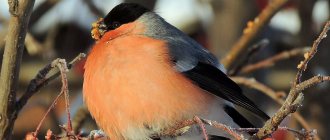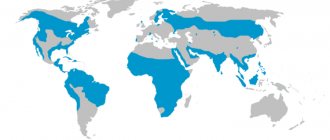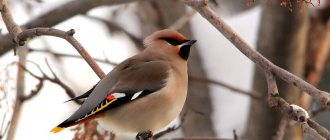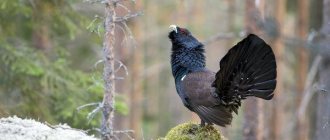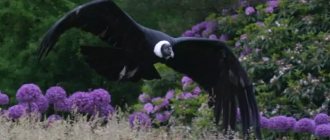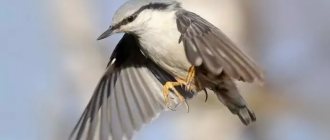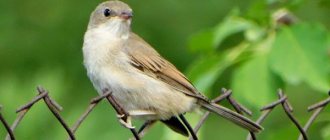- Where do hawks live?
One of the most dangerous, fast and furious predators among birds, of course, is the hawk, which has been noticed by people for its qualities since ancient times. It got its name due to the speed and swiftness of its flight; the word “astr” means “fast”, “swift”. Thus, the word “hawk” can be translated as “a bird with swift, swift flight.” And this characteristic accurately describes the essence of a hawk.
Description, structure characteristics
As for notorious predators, the size of hawks is relatively small - the largest of the hawks, the goshawk, weighs 1.5 kg, the length of the wings is no more than 30 cm and reaches a size of up to 68 cm in length. On average, the wing length of a hawk is no more than 26 cm, the weight of the hawk is 120 g, and the body length is 30 cm.
There is always feathering on the hawk's head. The hawk's beak is short, curved, strong, typical of birds of prey. At the base of the beak there is a cere, which is a bare area of skin where the nostrils are located.
The eyes of a hawk are usually yellow or yellow-orange. It’s no secret that hawks have simply excellent vision, which is about 8 times sharper than our human vision. The eyes of this bird are turned slightly forward, so hawks use binocular vision and can clearly see an object with both eyes. Hawks' hearing is no less developed, but charm is by no means their strong point.
The color of hawks is usually gray-brown, gray, brown on top, while their bodies are light below: whitish, yellowish, ocher, but with dark transverse stripes. Although there are species of hawks, such as the light hawk, with lighter colors. It also happens that hawks of the same species can be colored differently.
The paws of hawks are yellow, the paws themselves are very powerful, possessing sharp claws that serve the hawks when hunting.
The hawk's wings are short and blunt, although species living in less wooded areas (song hawks, for example) have larger wings. The structure of their wings is explained by the conditions in which hawks live. And since they live in forests, everything is arranged in such a way that they have excellent maneuverability, a hawk can deftly fly through dense thickets, make instant turns, both in the horizontal and vertical directions, take off sharply and stop sharply just as quickly, make rapid throws. Thanks to such abilities, hawks always attack their prey unexpectedly. The wingspan of a hawk is up to 125 cm.
Hawks have the ability to make “kee-kee” sounds, which probably serve as some kind of communication between them. Among them there are also special singing hawks, whose sounds are very melodic, they are similar to the sound of a flute.
Lifestyle and behavioral characteristics
Forest thickets become the favorite habitat of hawks, where they can safely build their nests on the tallest trees. This helps the birds monitor any activity in the area. The hunting grounds of hawks themselves are located over a large area, the size of which can be more than 100 square kilometers.
Predators feel good in dense thickets among tall trees, as their flight characteristics give them the ability to maneuver well even in such difficult terrain. Their ability to instantly move in any direction leaves the victim virtually no chance of salvation. Hawks deftly turn around and stop, which allows them to change direction at any time.
Birds usually eat the caught prey whole, with giblets. This method of feeding makes it possible to directly obtain all the necessary nutritional components and allows you to make a kind of internal reserves. Usually the victim dies in the hands of the hawk, as he receives serious injuries due to the strong and sharp claws.
Birds do not have unique vocal signals by which they can be recognized. They communicate with a broken or drawn-out sound, reminiscent of a sharp “ki-ki.”
There are hawks that can communicate with each other using more melodic sounds.
Social structure
Hawks are solitary by nature, so they live mainly in pairs, preferring to avoid large gatherings of relatives. At the same time, birds are monogamous and, like swans, choose a partner once and for life. They unite in flocks only when wintering time comes and the hawks have to fly south. The rest of the time, each couple lives on their own.
Hawk family
Males in pairs show themselves as selfless and devoted protectors. They vigilantly monitor everything that happens on their territory, do not allow outsiders, and protect their partner and offspring. Birds always show great caution, despite the fact that they are excellent predators.
Nutrition
As we already wrote above, hawks are incorrigible predators; the basis of their diet consists of smaller birds, small mammals, fish,
frogs, snakes, can attack and eat even large insects. But their favorite food is the same feathered smaller birds: sparrows, finches, finches, wrens, thrushes, tits. Sometimes hawks can attack larger woodpeckers, pheasants, pigeons, crows, parrots, and even hunt domestic chickens. Among the mammals that go to hawks for lunch are mice, rats, voles, squirrels, rabbits, and hares. But Japanese hawks sometimes even hunt bats.
During a hunt, cunning hawks first lie in wait for their prey, then unexpectedly and swiftly attack it. At the same time, hawks are capable of equally dexterously catching both sitting and flying prey. Grabbing her with his powerful paws, he squeezes her tightly, while piercing her with his sharp claws. After this, it eats its victim.
But what do little hawks eat? These young predators eat worms, flies and
mosquitoes
What does a goshawk eat?
Photo: Goshawk bird
The hawk is a bird of prey and it feeds exclusively on animal food. Young birds can catch large insects, frogs and rodents, but by the time they reach sexual maturity, goshawks move on to catching other birds.
The largest part of the hawk's diet consists of:
- pigeons;
- crows;
- magpies;
- blackbirds;
- jays.
Hawks at peak physical condition can easily hunt ducks, geese, wood grouse and black grouse. It often happens that a feathered predator copes with prey that is equal to it in weight and even larger.
A short tail and powerful wings help the hawk to actively maneuver and quickly change direction of flight. If necessary, the bird even hunts between trees, catching up with hares and other small mammals. When a hawk is hungry, it will not miss the opportunity to catch a large lizard or snake basking on the rocks.
Interesting fact: The goshawk, trained as a bird of prey, is capable of attacking even moose or deer. Of course, the bird cannot cope with such large prey, but it “slows down” the animal and allows a pack of dogs to attack the prey.
Hunters try not to hunt in areas where the goshawk lives. This is due to the fact that the feathered predator scares away or destroys other birds within a diameter of several kilometers. Such a hunt will not bring results and will not bring pleasure.
Difference from falcon
Hawks are often confused with other birds of prey - falcons, but let's try to describe the differences between them.
Origin of the species
The goshawk species is considered the most ancient on the planet. In mythology, hawks were considered to be messengers of the gods. And in Ancient Egypt, the eyes of a feathered bird meant a symbol of the moon and the sun, and wings as a sign of heaven. According to Slavic traditions, warriors painted the image of a hawk on their banners, thereby conveying their superiority over the enemy.
The domestication of hawks and joint hunting with them dates back more than two thousand years. Nowadays, people also willingly go into the forest for game, taking with them not a dog, but a bird of prey.
Difference from a kite
Hawks are also confused with kites; below we will present the main differences between these birds.
- The kite has shorter and weaker legs compared to the hawk.
- The tail of a kite is strongly notched, while that of a hawk is rounded.
- The beak of a kite is more elongated and weaker than that of a hawk.
- But the wings of a kite, on the contrary, are longer than those of a hawk.
- The kite is not as skilled a hunter as the hawk; its diet usually consists of carrion, garbage, and sometimes it can even steal food from other birds of prey. The same cannot be said about the hawk, an excellent and skillful hunter.
Population size
The remaining number of individuals can only be estimated approximately. Ornithologists involved in this matter are not always confident in their figures, fearing that the reality could be much worse. Relict forests are decreasing throughout the planet not only as a result of human activity, but also due to the increasing frequency of massive fires and unfavorable climate changes.
And for no more than five pairs of hawks to live, an area of 100,000 square meters is needed. Here is the known data on the distribution of goshawks: ⦁ up to 14 thousand individuals live in the United States of America; ⦁ on the African continent 20 thousand; ⦁ Asian countries account for no more than 35 thousand; ⦁ in the Russian Federation there are approximately 20-25 thousand birds; ⦁ in Europe there are about 4 thousand individuals.
Types, photos and names
Next we will describe the most interesting species of hawks in our opinion.
goshawk
This representative of the hawk family is the largest of them, its weight reaches 1.5 kg, body length is 52-68 cm. Moreover, females are larger than males. Also, due to its size, this species is also called a large hawk. Its feathers are short and slightly curled. Brown on top and white on bottom. It lives in Eurasia and North America, and is also found in Africa, but only in Morocco.
African goshawk
A hardy bird with strong legs and sharp claws. The body length is 36-39 cm, weight reaches 500 g. The colors are darker. As the name suggests, the African goshawk lives in the northern, eastern and western regions of Africa.
Sparrowhawk
He is also a small hawk - a very small representative of the kingdom of hawks. Its body length is only 30-43 cm, and its weight is no more than 280 g. Its color is typical of hawks. The habitat of the small hawk is almost all of Europe, as well as the northern regions of Africa.
light hawk
It got its name due to its bright light color. Although zoologists distinguish two varieties of this type of hawk: gray and white, again depending on the color. Light hawks live exclusively in Australia.
Crested Hawk
Lives in Southeast Asia. A distinctive feature of this species of hawk is the presence of a comb or crest on the lower part of the back of the head. Otherwise, the crested hawk is similar to its other relatives.
European tuvik
He's a short-legged hawk. Another small representative of the genus of hawks, has a body length of 30-38 cm and a weight of up to 220 g. The legs of this hawk are short, hence the second name. It lives in southern Europe, including in the south of our country Ukraine, and also in the Ukrainian Crimea. This species of hawk is thermophilic and with the onset of winter cold it goes south for the winter - to northern Africa, Asia Minor, Iran.
Red Hawk
It is also a very large representative of the hawk family, its length reaches 60 cm, and all 1-1.4 kg. Its plumage is reddish with various black spots. The red hawk lives exclusively in Australia; it loves parrots (as food, of course) and other smaller feathered animals.
Where do hawks live in the wild?
Hawks have a very wide habitat: their population is distributed on all continents except the Arctic. Representatives of the species are found throughout Eurasia: from the forest-tundra to the south. Birds feel good in America, Africa, Indonesia, and Madagascar.
Predators can be found in the Savannah, tropical jungles, coniferous forests and mountains. They love to live on the edges or in coastal vegetation. Some representatives of the species like to live in open areas, but this is rather an exception. They are often forced out of these places by hunters, who find it easier to catch birds in open areas.
The forest is a common habitat for hawks
Hawks living in temperate latitudes are sedentary birds. Those that live in the northern regions are sent to warmer places for the winter, including southern countries.
Reproduction
Hawks are family birds that love to build solid nests for their offspring. These birds begin nest construction 1.5-2 months before mating, in deciduous or coniferous forests. Nests are usually built from dry twigs.
Fun fact: Hawks are monogamous and mate for life, just like swans. They lay their eggs once a year and do this for several days. A clutch can contain from 2 to 6 eggs. The female incubates them, and the male, as a decent breadwinner, brings food.
After the chicks hatch, the male continues to bring food for a couple of weeks, but it is their mother who feeds the little hawks. After some time, the female also begins to fly out to hunt, but for another 1-2 months the parent hawks continue to care for their offspring. Having matured and become independent, young hawks fly away from their parents’ nest forever.
Hawks' home
Hawk nests always look different. Some birds build them carelessly, “in a hurry,” while others do it conscientiously and hardworking. Their housing is always located on tall trees, allowing them to protect themselves from uninvited guests and have the opportunity to observe the situation.
The construction of a nest always occurs between partners through joint efforts. This process begins approximately 1.5 months before the start of the mating season and mating. Construction usually begins in late winter. Dry branches, green shoots, bunches of pine needles, and pieces of tree bark are used to build housing. The nest itself is located in the forest, but not far from open areas - roads, meadows, swamps, etc.
Hawks do not always prefer to build a new nest for the mating season. Some couples use their old nest, others climb into other people's “houses”.
After 1-2 years, hawks can return to the place where their old nest is located and begin building a new one nearby. In the renovated house they have chicks, take care of their offspring, but then return to their old home. Birds renew it with the help of building materials and have the next generation of chicks already there. Thanks to such upgrades, the nest becomes wider and more spacious every year, which provides enough space for small chicks.
In this case, the second nest does not always remain empty. It can be occupied by other hawks and even representatives of other bird species that get along well with their relatives.
What to feed at home
Keeping a hawk is quite an exotic matter, but nevertheless, if you have a representative of this feathered family in captivity, keep in mind that the hawk should be fed with food that is natural to them - it is best if it is rodents purchased in a special store. You can, of course, feed it with store-bought meat, but such food will not provide the hawk with all the nutrients it needs. Also keep in mind that in captivity these birds experience extreme stress and it is possible that at first the hawk will even have to be force-fed.
Goshawk in the Red Book
Constant disturbance by people during the nesting period, illegal shooting, destruction of nests - all these factors have led to a decrease in the number of goshawks.
Current population situation
Goshawk - This individual is a vulnerable species and its numbers were estimated to be greater than thought. But according to the latest forecasts, there is a possibility that the population is beginning to decline. Therefore, the state of the species is equated with threats.
Current population estimates are as follows:
- Russia – 25,000;
- Asian countries - 35,000;
- Africa – 20,000;
- USA – 30,000;
- Europe – 4,000.
Of course, the calculations are approximate, but there is a possibility that for every hundred thousand square meters there are 4-5 hawks.
Are protective measures required?
Currently, due to the small population, drastic measures have been introduced to protect bird predators:
- habitat protection;
- restricted access of tourists to the nesting site;
- Landowners who protect nests are encouraged.
Research is also being carried out on the fragmentation of habitats for this species.
Interesting Facts
- In some places, small birds live under the nests of hawks.
hummingbird The fact is that hummingbirds are not of gastronomic interest to hawks, but their natural enemies: jays and squirrels, on the contrary, are very interesting. Thus, hummingbirds, with the help of hawks, protect themselves from squirrels.
Natural enemies of hawks
Due to the fact that hawks are dangerous and agile predators, they do not have many natural enemies. The bird's high position in the food chain ensures its immunity and the fear of other predators of the hawks' abilities.
The hawk is ready to attack
For young individuals, the main threat is foxes. These are cunning and dangerous forest predators, capable of guarding prey for a long time. If the parents are not careful, the fox may well attack the nest and take the chick with it.
At night, the main danger for hawks are owls and eagle owls, which are nocturnal predators. They take advantage of the fact that hawks cannot see well in the dark and attack their nests, where small chicks live. At night, they may not fear retaliation from adults.
Other birds of prey can also be a threat to little hawks. For example, larger eagles can dominate birds and even hunt them.
Cannibalism is common among hawks. In the absence of food, they are able to eat their weaker relatives or attack their chicks.
Another dangerous enemy of birds is humans. Hunters often exterminate hawks for their unusual plumage, trying to make a beautiful stuffed animal. In addition, people often cut down the forests that make up the natural habitats of birds, forcing them to migrate to other areas.
Video
And in conclusion, an interesting documentary about hawks from the National Geographic channel called “Goshawk - Phantom of the Forest.”
Author: Pavel Chaika, editor-in-chief of Poznavaika magazine
When writing the article, I tried to make it as interesting, useful and high-quality as possible. I would be grateful for any feedback and constructive criticism in the form of comments on the article. You can also write your wish/question/suggestion to my email [email protected] or Facebook, with respect, the author.
Author page
Symbol in mythology
The mystical symbol of the hawk is present in almost all beliefs and legends of ancient peoples. Sometimes the image of birds of prey united kites, hawks and falcons together. The symbolic expulsion of the predator from the settlement embodied deliverance from evil and death. The bird's gluttony requires a lot of food, so often the strongest representative of the species survives in the nests, eating its fellows. The image of a hawk in world culture is quite ambiguous, combining the symbolism of a dark beginning, death and the image of sunlight, acting as a messenger of the gods. The bird is an invariable attribute of the patrons of the Sun. Ancient peoples believed that she was able to fly to the star without taking her eyes off or blinking.
Russian legends depicted the image of a hawk as a threat, danger, and militant aggressiveness. It was believed that the origin of the Slavic name takes its roots from “str” - meaning the speed of reaction, flight, and “reb” - the definition of variegation, ripples in the color of the bird. The symbol implied swiftness of attack in the fight against the enemy. European peoples revered this bird. In England, during the reign of Edward III, killing a bird was punishable by death, and destroying nests was punishable by one year in prison for each roost.

